Planning is an essential part of a backpacking trip. You begin by planning which places you would like to visit. Then you move onto planning the logistics for the entire trip. For example, you will have to decide how you will travel from one place to the other in your itinerary. Do you take trains (which would be the preferred option if you want to enjoy the picturesque views in Europe) or flights (which might be viable from a financial perspective in Southeast Asia)?
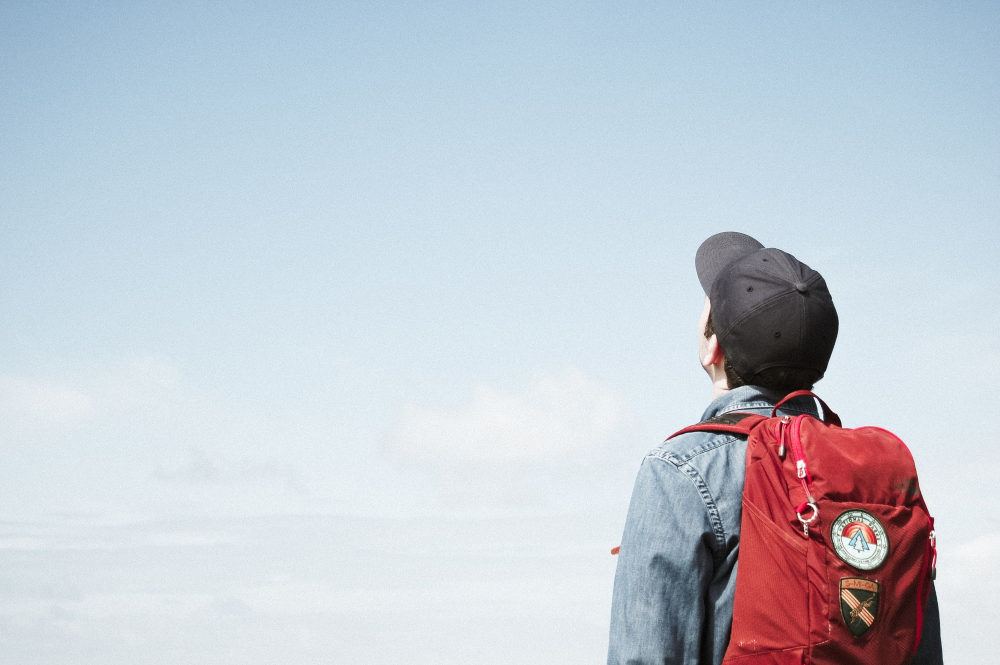
Once you have the logistics in place, you have to get down to organizing all the visas and documents required to visit all these places. You will also have to set up a budget and figure out how much you can afford to spend on hotels, hostels or Airbnb rentals and what your per day expenditure on essentials such as food, water and local travel (taxis, or tuk-tuks) can be. While planning all of this it’s possible to overlook one other key aspect, like how to pack clothes in a backpack?
There’s an art to perfectly packing clothes in a backpack, but a degree of planning and preparation augments the process. Before we get down to the particulars of how to pack clothes in a backpack, it’s important to have a clear idea of which clothes you want to carry with you on this trip, which clothes you need to carry with you on this trip and can all or some of the clothes that you want but don’t need be discarded at the outset?
Table of Contents
Which Clothes Do You Need for the Trip?
The importance of thoroughly planning a backpacking trip comes to the fore once again. If you have studied the places you will be visiting during the trip, you will have a clear idea about the climate of these places and the expected weather conditions at the time you will be visiting. You should also speak to friends, colleagues or fellow backpackers who have already visited the place or a neighboring place to find out more about what to expect during the time of the year you will be visiting.
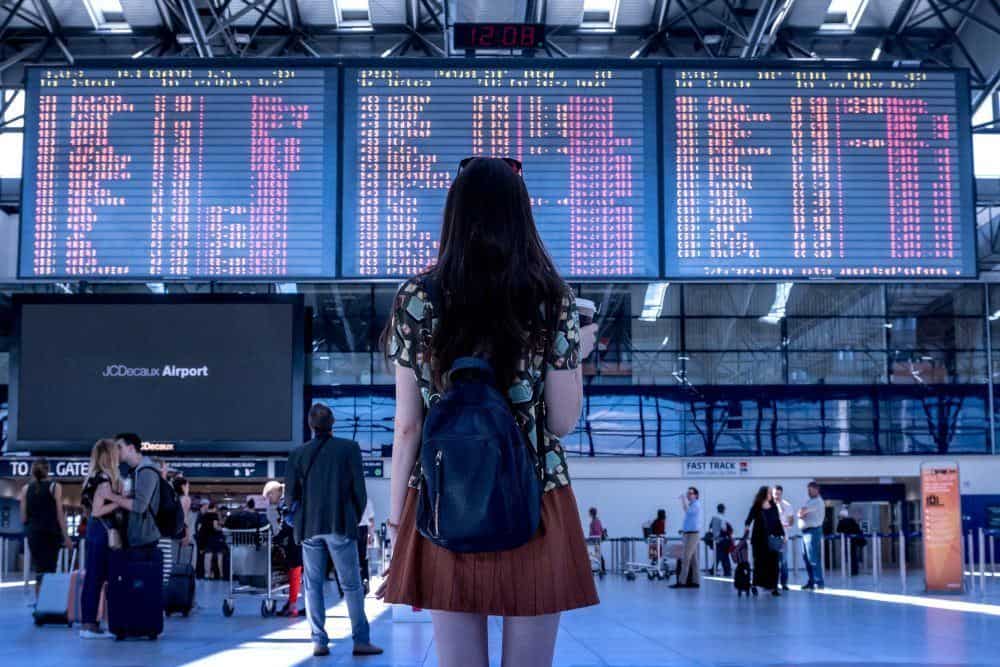
This will equip you with enough information to determine if you need to carry a mixture of warm weather clothing and a few colder weather clothing, or if just one or the other will do fine. You will also be able to determine if you should carry a raincoat for possible rain during that period.
In terms of type(s) of fabric you should pack and those that you shouldn’t, remember to avoid cotton as much as possible. Maintaining cotton clothing during a backpacking trip becomes very difficult. Plus, cotton clothes tend to wrinkle a lot more. Clothes made of lightweight synthetic materials are the best.
These materials breathe well and can be packed smaller than cotton. It’s also easier to wash and dry them. You can simply wash them over a sink in the dorm. Note that on average clothes made of lightweight synthetic materials will cost a little more, but the convenience they make them worth the extra money.
However, not all of it is down to planning. You will have to make judgment calls as well. Do you really need ten t-shirts and five pairs of shorts for the trip or can you make do with five t-shirts and three pairs of shorts? Will it be possible for you to pick up cheap t-shirts in the city/ country you will be visiting? If yes, do you really need to carry more than two t-shirts? You need to take into consideration similar factors for other types of clothing you will be carrying with you such as sweatshirts, jackets, trousers, jeans, underwear, and socks.

Footwear can be considered to be part of the same group as clothes, for the purpose of planning how to pack clothes in a backpack. Wear the heaviest or biggest piece of footwear while you’re traveling from your hometown or country to your destination. It will reduce the weight of your backpack to a certain extent.
For example, wear your Doc Martens instead of packing them in the backpack. Keep the number of footwear you carry, including the one you will be wearing, down to two or three at most. A pair of comfortable walking or running shoes and a pair of airy, comfortable sandals are the essentials. You can add a pair of slippers to this. The walking or running shoes can be substituted for hiking boots if you will be traveling predominantly over rugged terrain.
Roll Your Clothes
To efficiently utilize space inside the backpack, roll your clothes before packing them. The army roll technique is ideal for t-shirts. You need to fold a narrow part (5-6 inches) of the bottom of the t-shirt inside out, followed by centering both the left side and right side of the t-shirt. The sleeves will have to be folded back in to ensure it doesn’t stick out. Finally, from the collar end of the t-shirt, roll it into a compact cylindrical shape. The narrow bottom section you had folded initially can now be used to secure the roll and ensure it holds the shape.
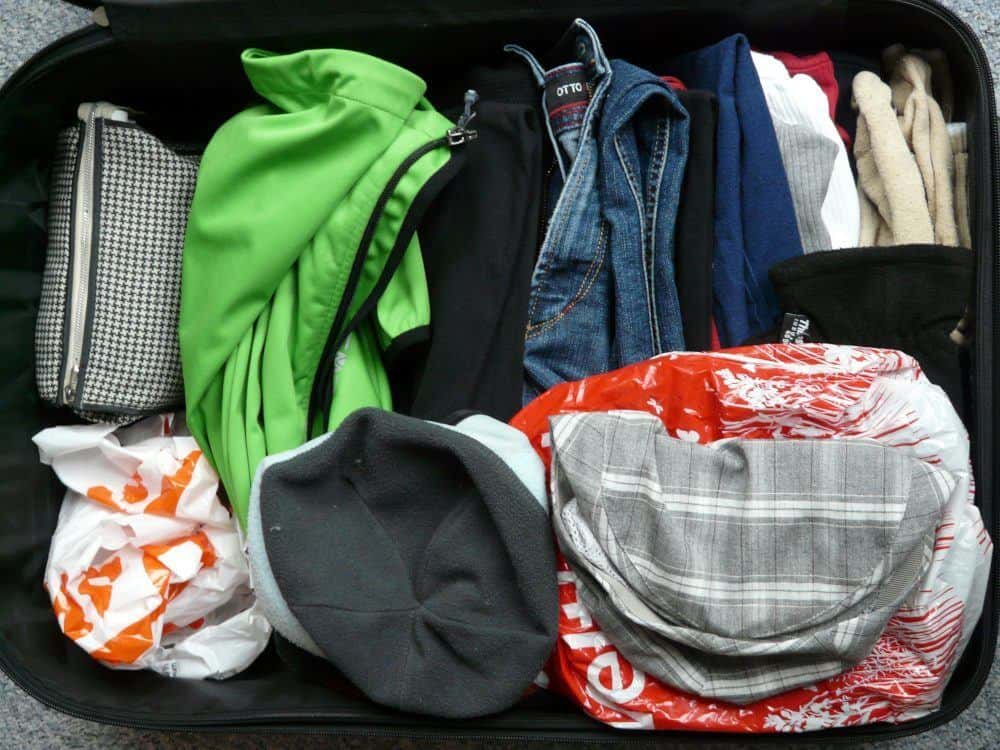
While this roll technique won’t prevent wrinkles completely, it will allow you to pack your clothes in a smaller backpack than you would have otherwise required.
For jeans and shorts, fold them in half, vertically and then roll them up. Tie them up with large rubber bands to ensure the rolls hold their shape. You can do the same for your socks and underwear as well.
You can also roll multiple clothes together to save space. Place a pair of jeans, vertically folded in half, on a flat surface. Place a t-shirt, with both sides centered, sleeves tucked in and folded in half, over the jeans. Place one piece or one set of underwear, over the t-shirt. Now roll this up tightly.
While traveling, you can simply pull this roll out and wear them. You won’t have to spend much time thinking about what you are going to wear that day. You can do the same with your other clothes to create ready to wear ensembles.
Obviously, this doesn’t work if you’re packing 10 jeans and 10 t-shirts. Rolling up all of these clothes will, in fact, be counterproductive. However, if you’re traveling light, with two or three jeans and less than half-a-dozen t-shirts, then this "roll-multiple-clothes-together" technique can be very useful.

There are twin advantages to rolling your clothes. Firstly, the degree of wrinkling is much lower when your roll your clothes as compared to when the clothes are just folded and stacked on top of each other in the backpack. The clothes are squished from both ends and form wrinkles.
When the clothes are rolled, pressure from either or both ends squishes them inwards and prevents extensive wrinkling. Secondly, while repacking during the trip, there will be less chances of the backpack bloating due to misplacement of the various things in it. The rolled up clothes can squeezed into the corners and gaps and ensure you don’t waste time repacking.
If you really want to master how to pack clothes in a backpack, then you need to learn how to utilize any hollow space within the backpack to store some of the clothing items. For example, you can stuff your socks into the shoes that you’re packing to save some space. If you’re on a hiking trip and carrying utensils, the hollow space within the utensils can be utilized to pack some rolled up t-shirts, your underwear, and others. This will allow you to pack more stuff than you would normally be able to.
Compression Dry Bags
Rolling up your clothes does help utilize space in the backpack more efficiently and enables you to carry a smaller backpack. But compression dry bags enhance the efficiency levels of how to pack clothes in a backpack by several notches. A compression dry bag eliminates all excess space taken up by the clothes due to the air caught in them.
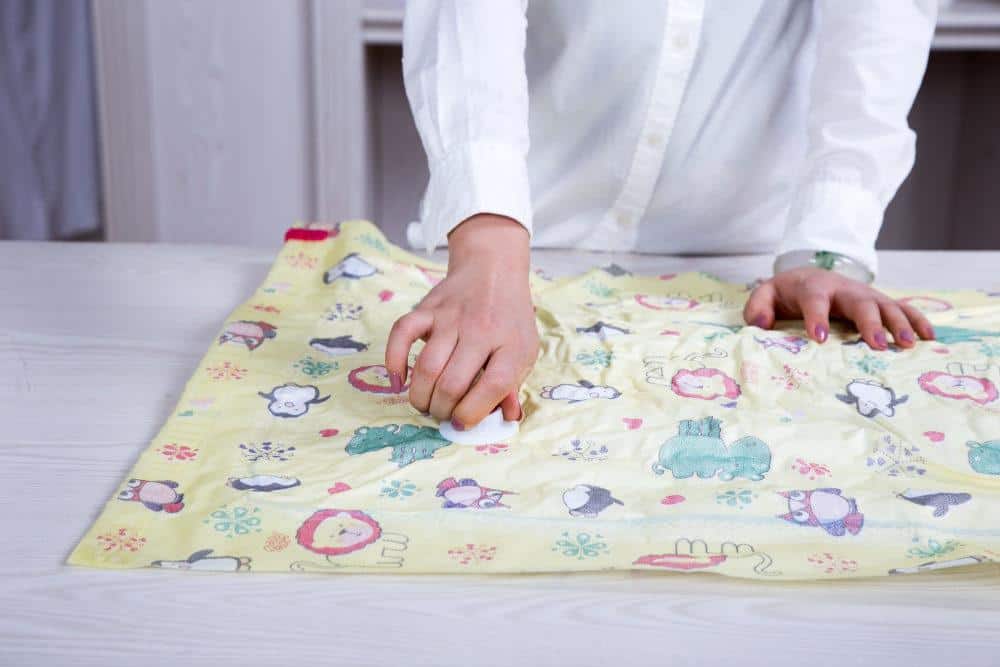
The clothes are packed more compactly and can even be shaped to fit the space available in the backpack. There are some unused spaces in the backpack when clothes are rolled up and packed, though it’s significantly lower than the amount of unused space left when clothes are folded regularly and packed. Compression dry bags ensure that any unused space is utilized. So, if you have been using a 80-liter backpack for your travels, compression dry bags can enable you to pack all of the same things into a 50-60 liter backpack.
You can get dry bags with side straps or sling straps that can be used as day bags for trips to the beach. The wet clothes can be carried in waterproof dry bags and even packed in the backpack without damaging any of the other things in it. You can keep a spare dry bag to pack or carry your wet towel, sweaty socks, washed clothes that haven’t quite dried yet, etc.
You can buy a good quality waterproof compression dry bag for between $20 and $30. While buying a compression dry bag make sure to check the rim and the clip. The rim and clip make the dry bag airtight and keep it secure. It these aren’t of a good quality, the effect of compression will diminish over time.
Spend a few extra dollars, if required, to buy good quality compression dry bags, instead of the cheap plastic vacuum bags that don’t last long. It also makes sense to buy at least 2-3 dry bags in different colors. You can pack t-shirts in one, keep jeans and shorts in the second and use the third for your underwear. The different colors will allow you to identify which dry bag contains which set of clothes more easily and will also make the process of repacking faster.
Packing Cubes
Packing Cubes are different from compression dry bags. These don’t compress or remove excess air from the clothes. However, these are quite handy in packing your clothes in an organized manner. Packing cubes are available in various sizes. So, you can pick up one for t-shirts and shirts, another for your jeans and shorts and one for underwear.

While these will use up more space than a compression bag will, all your clothes will be segregated and organized. You can unpack the packing cubes individually and while repacking simply put them back into the backpack. As mentioned earlier, dry bags also allow you to be organized in your packing. Hence, compression dry bags are a better option than packing cubes.
Clothing Folder
Compression dry bags and packing cubes are great for t-shirts, jeans, sweatshirts, etc., but not for button down shirts. If button down shirts are packed in a compression dry bag, they will get completely crumpled and crinkled. You will need a clothing folder for button down shirts.
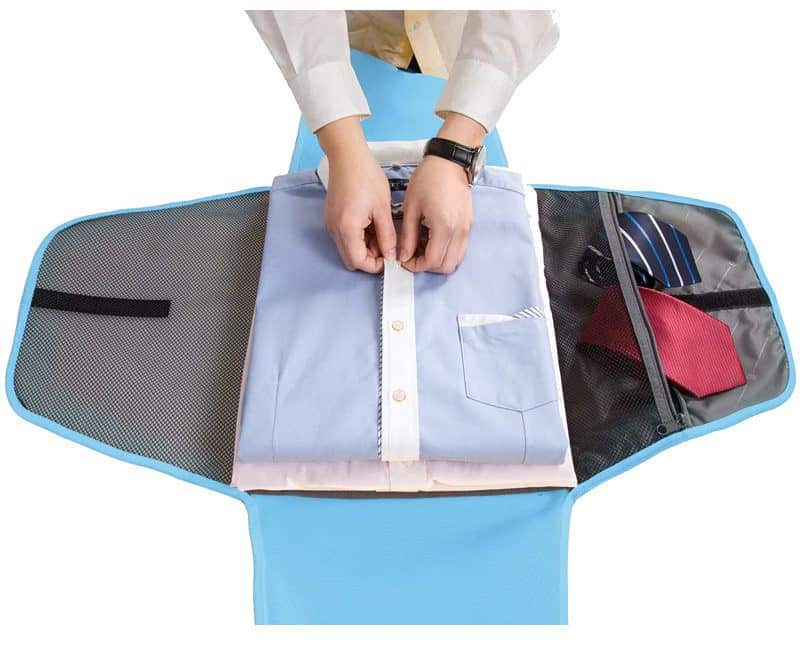
Source: aliexpress.com
These mesh folders can be opened up flat and come with a folding board. The shirts are placed on the folding board, which helps you fold them in such a way so as to minimize wrinkles. Once the mesh folder is closed and locked, you can slide them down the side of the backpack. It won’t take up much space and will keep your shirts wrinkle free.
Pack Light
Every country or region has low-cost airlines. The carry-on and check-in baggage limits often vary from one low-cost airline to the other. If you’re backpacking through multiple countries, you might have to use different low-cost airlines and if your backpack is heavier than the accepted baggage limit in any of these airlines, you might have to pay a fine, which will eat into your travel budget.
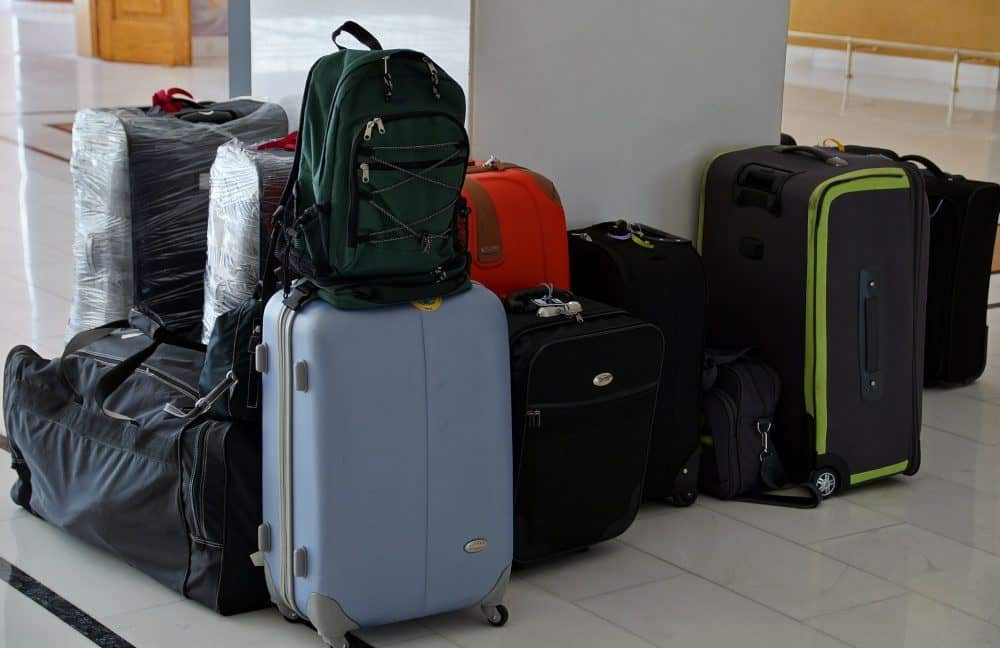
To avoid this, do a quick online research about the airlines in a particular region and make sure that your backpack is lighter than the accepted baggage limit. Alternatively, you can break up your things into two separate backpacks. One bigger backpack that becomes your check-in luggage and one smaller backpack that you can carry into the flight.
This isn’t the only reason you should pack light. As you travel through new cities and countries, you’re bound to pick up mementos and other things that will add to your backpack weight. If you already have a heavy backpack, these new things will make it almost impossible to carry. Or, you will have to stop yourself from buying anything to remember the places and experiences by, which isn’t good either.
Lightest to Heaviest
At this stage, you have all the information you will need to organize and declutter your clothes. You have made decisions regarding whether you want to roll and pack all of your clothes, whether you want to use compression dry bags, packing cubes or clothing folders or not, and you’re aware that packing light is advisable for a backpacking trip.

Now you get down to the task of actually packing all of the things in your bag. Clothes and shoes aren’t the only things you will be packing, so the other things need to be taken into consideration as well. You might be carrying a sleeping bag, a few gadgets, toiletries, a medical kit and other things.
You begin by packing the lighter things such as the sleeping bag at the bottom of the backpack. Things that you will not need access to frequently such as your spare shoe(s) should be packed next. Now you can pack your clothes. If the clothes are in compression dry bags or packing cubes, it will be simpler. If you’ve decided to roll all of your clothes, place one roll at a time, making sure that you don’t leave unused space or gaps between the rolls.
The heavier items such as your gadgets, including your laptop and camera, should be packed in the middle of the backpack. The lighter items at the bottom will provide ample protection for the gadgets. Things that you will need easy access to, such as your toiletries bag, essential documents, etc. are packed at the top of the backpack.
If your backpack has external pockets and pouches, you can store these items that you need easy access to in them. If you are likely to need a jacket or sweatshirt on reaching your destination, or if you need to take off the jacket or sweatshirt you’re wearing, it should be packed last, along with your towel.
Conclusion
Many backpackers make the mistake of carrying too many clothes for a trip. So, for every piece of clothing you pack, you need to first ask yourself if you really need it or not. You will be surprised how many pieces of clothing you can eliminate from your backpack by asking this simple question.
You should also set yourself the goal of packing as light as possible. You want to experience the places you’re travelling to, soak in the sights and sound and not be bogged down by a heavy backpack. Happy backpacking!
Resources:
Two Scots Abroad
Real Simple
